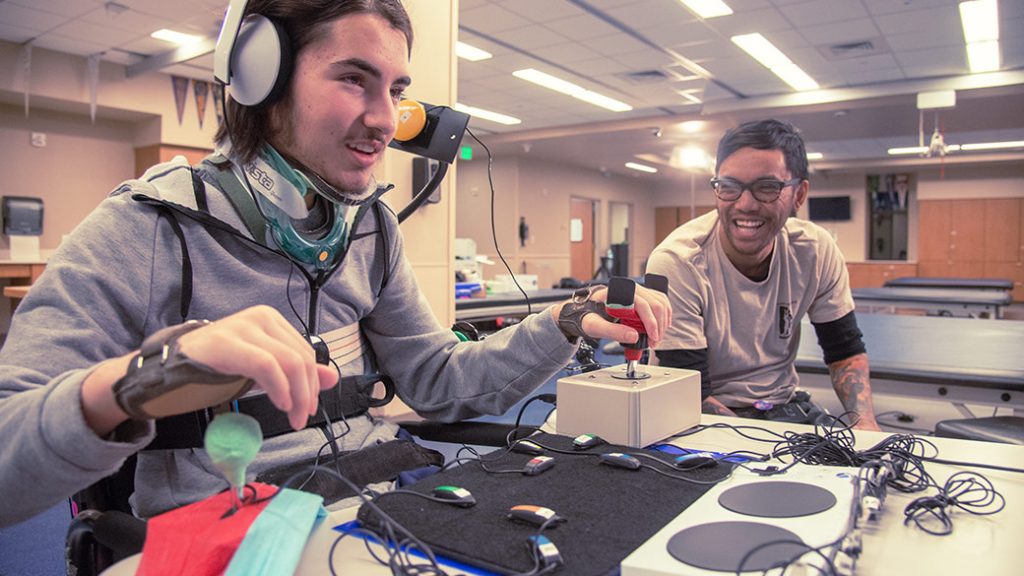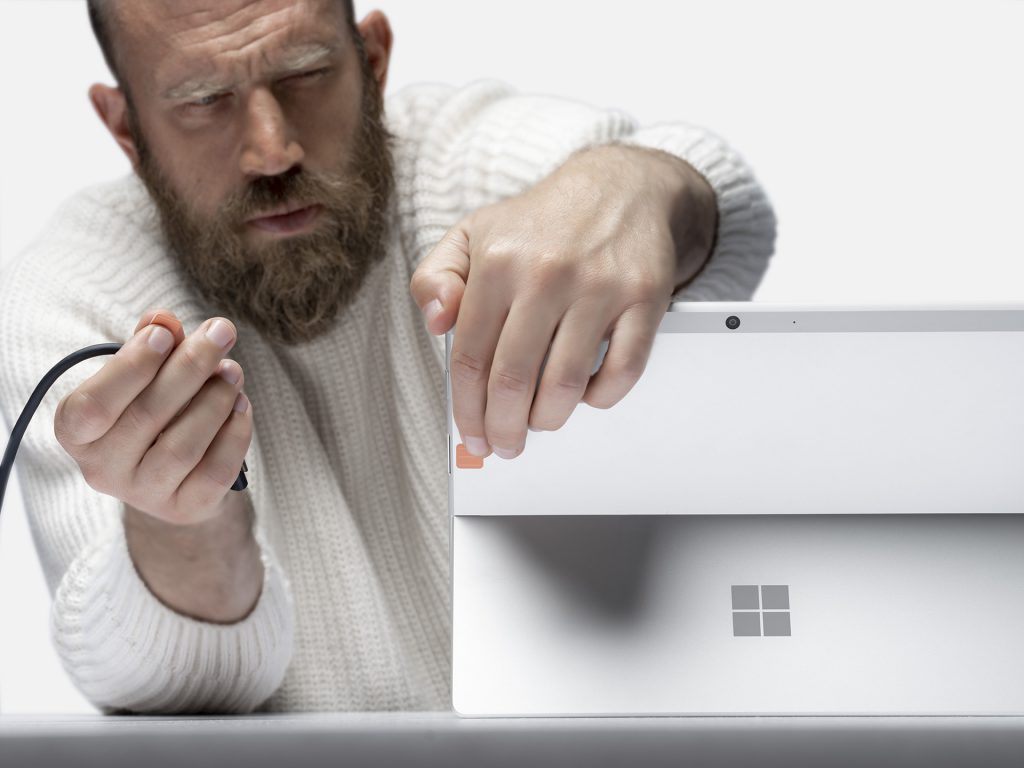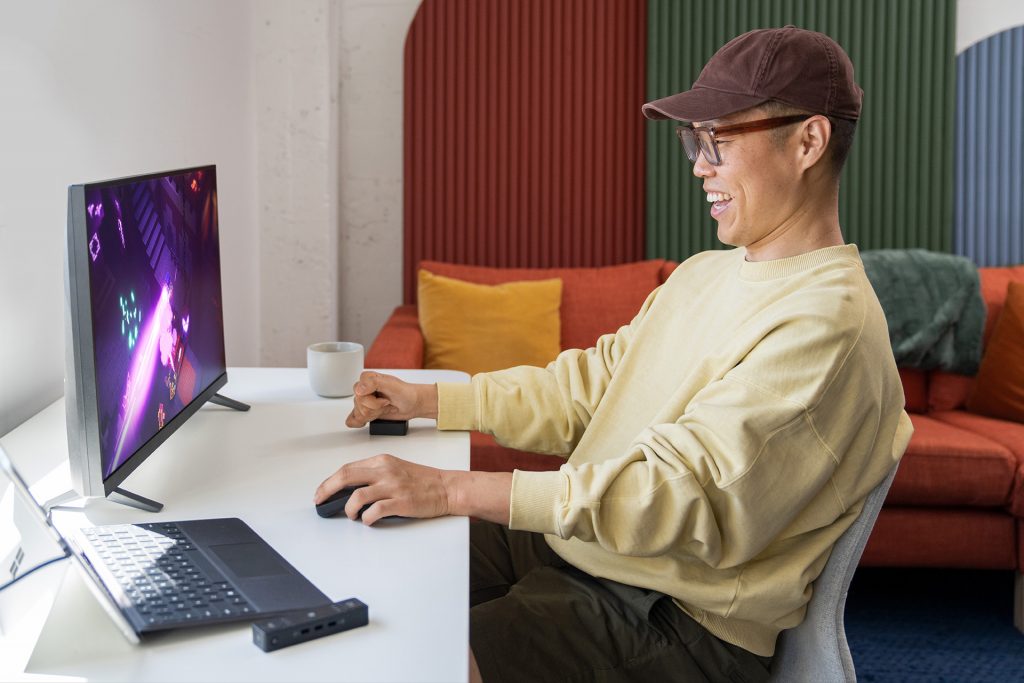Microsoft’s commitment to accessibility: Creating products and services for people with disabilities
As a person who is part of the disability community, creating products for our community is my passion. I am committed to ensuring we have technology that enables us to achieve more at work, in school and in our daily lives.
At Microsoft, we strive to close the disability divide by creating products that are accessible. As we enter Disability Awareness Month, we’re excited to share the products we have brought forward over the years – a variety of solutions to the many barriers to access the disability community faces across life and work.
We put people with disabilities at the center. We believe in the saying, “Nothing about us without us,” when it comes to designing accessible products. The Inclusive Tech Lab on Microsoft’s campus gives us space to learn from members of the disability community about the barriers they face, and design solutions together. This facility is for people with disabilities, not about people with disabilities.
We guide designers and engineers to intentionally include people with disabilities in the products and services they create. We work with people with disabilities, organizations and therapists across numerous companies, school districts and rehab facilities to understand their needs and challenges. We bring together designers, engineers, interns and external partners through Inclusive Design Sprints, Microsoft Hackathons and Microsoft Garage to co-create innovative solutions. Hackathons generate a variety of ideas and prototypes to address the many barriers to access that people face in different contexts. The resulting products can then be showcased, tested and improved by the wider community, leading to more inclusive and impactful outcomes.
We design with a “one size fits one” approach, creating products that are adaptable and can be customized by each individual user to fit their specific needs and preferences. We care deeply about design and how it impacts our users. We heard from our users with disabilities that they don’t want to feel singled out by using assistive devices, and that many of the assistive devices on the market today appear too clinical. Within the Surface portfolio, design is a priority, and that shouldn’t be any different for our accessible accessories. That’s why we created our accessible accessories with the same sleek, stylish and deliberate design choices as our other devices.
The evolution of accessible products at Microsoft
Xbox Adaptive Controller: The launch of the Xbox Adaptive Controller in 2018 made it possible for customers with limited mobility to enjoy gaming on Xbox1 and Surface devices. The adaptive controller allows them to customize their controller setup with external switches, mounts and joysticks. A customer who has difficulty using their hands can use a foot pedal and a mouth-operated joystick to play their favorite games on their Surface Laptop Studio.

Surface Adaptive Kit: In 2021, we launched the Surface Adaptive Kit to enable customers who are blind, have low vision or experience limited mobility to make their Surface devices and peripherals more accessible. Customers with low vision can use the tactile labels to identify the keys on their Surface Keyboard and the port indicators to locate the ports on their Surface device2. Users with limited mobility can use the openers as support to open the lid and stand of their Surface Pro more easily, and the keycap labels to quickly find shortcut keys.

Microsoft Adaptive Accessories: The Microsoft Adaptive Accessories were developed with people who have difficulty using a traditional mouse and keyboard and launched in the fall of 2022 as a way to increase their PC productivity. Customers with limited mobility can use the wireless adaptive hub and buttons to augment or replace a traditional keyboard to use their favorite apps more effectively. They can complete tasks such as sending emails, writing documents, gaming and editing more easily. Users can also customize their own adaptive mouse and buttons with 3D printing attachments available through Shapeways.3,4

3D Printed Pen Grips for Microsoft Classroom and Business Pens: We released 3D Printed Grips for Microsoft Classroom Pen 2 and Microsoft Business Pen in 2022. The adaptive pen grips give students greater autonomy in the classroom, equipping them to write and take notes without relying on physical aid in class. Students with limited mobility or strength use a pen grip designed for their hand, reducing pain or discomfort. Professionals can use a pen grip that stabilizes involuntary hand movements, taking notes or signing documents with confidence.
New products coming this fall
We recently added two new products to our portfolio of accessible devices for Surface.
3D Printed Pen Grips for Surface Pen. Customizable 3D attachments are now available for Surface Pen. Now customers with limited mobility can be more creative and productive on their Surface devices5. We wanted to fix a mismatch and find a solution that enables people with disabilities to create, take notes and be productive in ways that the rest of the world takes for granted. Customers can choose from several shapes and sizes, with the option to add texture and select a unique tail cap. Every aspect of these designs was thoughtfully tuned through our partnerships with the disability community. We recognize that needs are always changing and we encourage others to invent and share their own pen designs with the community.
We partnered with Shapeways3,4 to make pen grips customizable, printable and shippable. The designs are also free to download on the Shapeways marketplace.

Surface Laptop Studio 2 – Adaptive Touchpad. The precision haptic touchpad in Surface Laptop Studio 2, announced this September, is the most inclusive touchpad on any laptop. Thanks to adaptive touch mode, users with limited mobility can use the trackpad with different parts of their limbs, such as the palm, the foot, edges of the hand, or residual limbs. This means precise mouse control with imprecise contact. The adaptive touchpad uses software and haptic motors to create realistic feedback when you tap or click on it. The adaptive touchpad settings live in the Surface app and can be turned on with a simple toggle switch.
Check out our video below to learn more about how to set up the adaptive touchpad on Surface Laptop Studio 2.
Accessibility features in Windows
Hardware is a crucial component of the user’s setup that enables them to personalize and interact with their devices in ways that suit their preferences and needs. Surface hardware reflects accessibility enhancements to optimize the in-app and Windows OS accessibility experience with high-quality microphones for dictation, video cameras for eye-control, and intuitive multi-touch screens that make UI interactions more tactile and natural. We have consistently introduced accessibility features in Windows to help build a more accessible Surface and Windows ecosystem. Some of the accessible tools and features in Windows are:
Seeing AI is an app that narrates the world for users who are blind or have low vision. Learning tools are designed to enhance focus, comprehension and learning for all users. These tools span from immersive reading and writing assistants in Word, OneNote and Outlook to inclusive math and communication features, all tailored to support diverse learning needs across various applications.
A familiar set of assistive technologies built into Windows 11, like Narrator, Magnifier, Live Captions and Voice access to support users across the disability spectrum. Additionally, Windows 11 provides accessibility settings such as: New contrast themes designed to provide maximum differentiation between text, backgrounds and color combinations on the screen for people with low vision and light sensitivity. Voice Typing, to help everyone author text with their voice, uses state-of-the-art artificial intelligence to recognize speech, transcribe and automatically punctuate text.
For those on Windows 10, we are also offering this experience: Eye Control, which allows Windows 10 customers to use their eyes to control an on-screen mouse, keyboard and text-to-speech experience. Ease of Access, which makes Windows 10 easier to see with the addition of text size customization, which works with Magnifier. Narrator, used to improve navigation and overall efficiency. Accessibility features within Microsoft Edge, such as: Automatic Image Description, which provides auto-generated alt text for images that do not include it. Immersive Reader and Read Aloud, which help improve focus for individuals by having articles and other content read to them. Editor in Microsoft Edge, which provides text prediction and proofing tools to help our customers write more confidently on the web. Finally, Accessibility Insights, a free downloadable extension for Windows, Android and web browsers that helps developers find and fix accessibility issues.
Conclusion
At Microsoft, we are passionate about creating products and services that are accessible for people with disabilities. To enable transformative change, we’re working to weave accessibility into the fabric of what we design and build for every team, organization, classroom and home. When we design with disability in mind, our products become better for everyone.
Disclaimers:
- Xbox Adaptive Controller is compatible with Xbox Series X, Xbox Series S, Xbox One X, Xbox One S, Xbox One, Windows 10/11, Android, iOS.
- Keycap labels of the Surface Adaptive Kit can fit on the keys on the Surface Go Type Cover and Surface Laptop Go but will require a more precise application due to the key size.
- 3D print services provided and warrantied exclusively by Shapeways, Inc. subject to Shapeways Sales Terms and Conditions and Warranty at: https://aka.ms/ShapewaysTermsConditions. Microsoft is not responsible for their performance or compliance with applicable regulatory, compliance, safety or any other requirements.
- Available 3D designs from Shapeways may vary from image shown and over time. See Get Started with 3D Printing for the latest offerings.
- Compatibility details can be found at Surface Pen Compatibility. Pairing functionality requires Windows 10 or 11 with the latest updates.
- Some software, accessories and devices sold separately.


